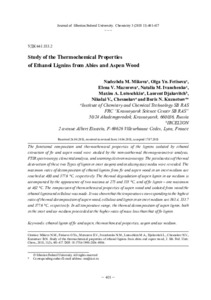Изучение термохимических свойств этаноллигнинов пихты и осины
Скачать файл:
URI (для ссылок/цитирований):
https://elib.sfu-kras.ru/handle/2311/107070Автор:
Микова, Н.М.
Фетисова, О.Ю.
Мазурова, Е.В.
Иванченко, Н.М.
Лутошкин, М.А.
Дьякович, Л.
Чесноков, Н.В.
Кузнецов, Б.Н.
Mikova, Nadezhda M.
Fetisova, Olga Yu.
Mazurova, Elena V.
Ivanchenko, Natalia M.
Lutoschkin, Maxim A.
Djakovitch, Laurent
Chesnokov, Nikolai V.,
Kuznetsov, Boris N.
Дата:
2018-09Журнал:
Журнал Сибирского федерального университета. Химия. Journal of Siberian Federal University. Chemistry ;2018 11 (3)Аннотация:
Методами неизотермического термогравиметрического анализа, ИК-Фурье-спектроскопии,
элементного анализа, сканирующей электронной микроскопии изучен функциональный состав
и термохимические свойства лигнинов, выделенных экстракцией этанолом древесины пихты
и осины. Выявлены особенности термодеструкции этих двух видов лигнина в инертной
(аргон) и окислительной (воздух) средах. Максимумы скорости разложения лигнинов пихты и
осины в инертной среде достигаются при 400 и 377,6 °C соответственно. В воздушной среде
термодеструкция лигнина осины сопровождается появлением двух максимумов при 275 и
355 °C, а лигнина пихты – одного максимума при 402 °C. Проведено сравнение термохимических
свойств древесины осины и выделенных из нее этаноллигнина и целлюлозы. Показано, что
температуры, соответствующие наибольшим скоростям терморазложения древесины
осины, целлюлозы и лигнина в инертной среде, равны 363,4, 333,7 и 377,6 °C соответственно.
Во всех температурных интервалах терморазложение лигнина осины как в инертной, так и в
воздушной среде протекало с более высокими скоростями убыли массы, чем лигнина пихты The functional composition and thermochemical properties of the lignins isolated by ethanol
extraction of fir and aspen wood were studied by the non-isothermal thermogravimetric analysis,
FTIR spectroscopy, elemental analysis, and scanning electron microscopy. The peculiarities of thermal
destruction of these two Types of lignin in inert (argon) and oxidizing (air) media were revealed. The
maximum rates of decomposition of ethanol lignins from fir and aspen wood in an inert medium are
reached at 400 and 377.6 °C, respectively. The thermal degradation of aspen lignin in air medium is
accompanied by the appearance of two maxima at 275 and 355 °C, and of fir lignin – one maximum
at 402 °C. The comparison of thermochemical properties of aspen wood and isolated from wood the
ethanol lignin and cellulose was made. It was shown that the temperatures corresponding to the highest
rates of thermal decomposition of aspen wood, cellulose and lignin in an inert medium are 363.4, 333.7
and 377.6 °C, respectively. In all temperature range, the thermal decomposition of aspen lignin, both
in the inert and air medium proceeded at the higher rates of mass loss than that of fir lignin

